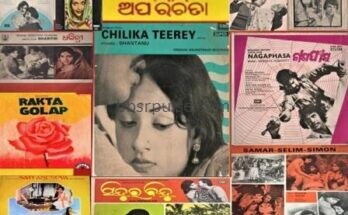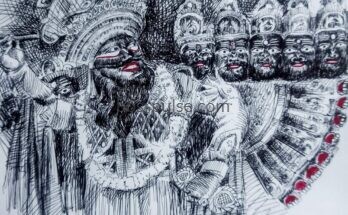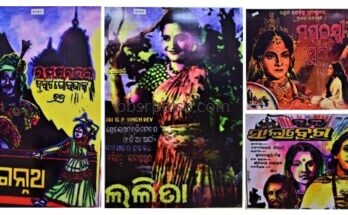“Bhrata me Kumbhakarna Sakala Pubala Dhwanshakari Baliyan
Putra me Meghanada Prahasito Badano Jen Baddha Surendra |
Khadga me Chandrahaso Ranamukha Chapalo Rakhyasa Me Sahayah
Sohey Girbana Satrus Tribhubana Bijayi Rabano Nama Raja ||
(Sanskrit Bachanika chanted by Rabana with a mix of Odia during Sahi Jata)

Puri is linked with spirituality & its cultural festival means Ratha Jatra. But often, a mega festival undermines the other local festivals in a heritage town like Puri. Sahi Jata is one of the lesser known street festival of Puri, almost unknown to the outer world. Like all traditional festivals in Puri, Sahi Jata too has it’s Sri Mandir connection. This centuries old performing arts tradition is kept alive by the local Jaga gharas/akhadas. Jaga Gharas were created to train the sebayats (temple priests) in wrestling & martial arts so that they can protect the Sri Mandir from external attacks during the need. And, during free time, the warriors entertain themselves by practicing/enacting various characters under Sahi Jata. Sahi means street & Jata or Jatra means theatre or procession related with religion. The vibrant festival of Sahi Jata which is performed during night time, turns the almost sleepy streets of Puri alive with beating drums, blowing trumpets & conch shells with the near perfection mythological looks & their dance steps as per Odra akhada tradition.

The folk street theatre of Sahi Jata revolves around the mythological story of Ramayana & its characters played mostly by the Jaga Ghara artists of the seven sahis (streets) around Puri Temple. Although the event is in Chaitra month (around April), the actual rehearsal starts at least one month before in the Jaga Gharas in the evening hours under the guidance of their respective akhada gurus who have years of experience in this performing art. Dedication in practice & abstinence (from certain habits) is expected from the artists who are mostly unmarried males of the Jaga Gharas except the Rabana character who can be married. The main characters in Sahi Jata are Rabana, Parashurama & Naga and they are recognized by the huge decorative taati (wooden frame) carried on their back with ease, maybe depicting the warrior’s attire of ancient times. The other lesser known characters are known as meddhas who have been added to fill the gap & entertain the audience in the absence of the main characters. It’s really amazing to watch these characters wearing heavy attires & beautifully decorated headgear made from sholacraft (organic thermocol), multiple heads made of papier mache dancing amidst enthralling crowd & moving in the narrow bylanes of Puri.
Sahi Jata is based on Ramayana & starts on Rama Nabami day, yet it’s not exactly Rama Leela since only some episodes of the Ramayana are enacted here & Rama plays an average role. Interestingly Rama, Laxmana, Bharata , Satrughana, Biswamitra, Dagara etc characters are carried out by nabalakas (young teenage boys) since they are symbolic & possess lesser importance here in Sahi Jata. Sahi Jata runs for average 10 days & there are bishrama dibasa (rest days) to give rest to the artists & the Ramabhisekha Utsab is kept at last which falls on Baisakha Trutiya day after Rabana Baddha. 
Daywise Sahi Jata Leela/Kanda (episode)
The seven sahi performs several kandas (episodes) of Ramayana through martial art & dance, the details which are as under –
Day #1. Sriram Nabami Day : Sri Rama Janma Leela at Kalikadebi Sahi
Day #2. Jagyan Rakhya Neeti at Harachandi Sahi . Mati Mandapa Sahi is partially involved in this neeti(ritual).
Day #3. Sita Bibaha & Parashuram Leela at Harachandi Sahi which moves to Bali Sahi with Sri Rama, Sita, Parashurama
Day #4. Rama Banabasha at Markandeswar Sahi which moves to Jagannath Ballabh Muth with Sri Rama, Laxman, Sita, Biswamitra & Dagaraa
Day #5. Sita Harana by Maya Rabana at Kundhaibenta Sahi which moves to Dola Mandapa Sahi with Sri Rama, Laxman, Sita, Maya Mruga (Maricha) & Maya Rabana
Day #6. Lanka Dahan at Dola Mandapa which moves to Kundhaibenta Sahi with Lankapodi Hanuman
Day #7. Setu Bandha neeti at Bali Sahi which moves to Hara Chandi Sahi
Day #8. Rabana Marana at Bali Sahi which moves to Harachandi Sahi
Day #9. Baisakha Trutiya: Ramabhisekha at Gaudabada Sahi with Sri Rama, Laxman, Bharata, Satrughana
Episodes are not on continuous basis, some days in between are kept as bisrama dibasa (rest days). A meeting is organized by Sata Sahi Akhada Samanyway Committee well before Rama Nabami in which all the Jaga Ghara Secretaries are invited. There only the episode dates & rest days are freezed in consultation with Sri Mandir Prashashan & as per Jagannath Panjika.
Characters under Sahi Jata
Rabana :- Rabana is virtually the king of Sahi Jata around whom the performing art revolves. His is wise, intelligent & mighty too & has the whose sahis as his followers & is greeted with garlands on his arrival. His skin tone is pitch black with heavy moustache, flaunts colourful yellowish attire, wears ghagudi (anklet bells) on his legs & carries the heavy wooden frame (taati) on his back which is worshipped before wearing. His headgear is quite bulky & is made from paper & sholacraft & his additional 9 heads from papier mache. His character is one, but as per episodes, he is given various names & enacted by three sahis. – Maya/Chadmabesi Rabana (enacted by Kundhaibenta Sahi), Lankapodi Rabana (enacted by Dola Mandapa Sahi), Setu Bandha Rabana & Jagyan Rabana (enacted by Bali Sahi) & Juddha/Baddha Rabana by Bali Sahi. Since, he is the principal character & protagonist, he is a always a strongman, delivers bachanika (dialogues) with a mix of Odia & Sanskrit with perfection. He is seen flashing his weapon – shakti in his hands. He carries the whole weight, performs dialogue in thaani (swag), grooves to the musical steps of the mardalaa & telingi baja while moving with the flag & torch bearers. Its quite enjoyable watching excited spectators cheering Hari Bola & Hey! Hey!! to encourage the lead characters!
Parashurama :- Parashurama is the most handsome character of the Sahi Jata festival. He is basically a warrior rishi dressed in bright yellow & is seen brandishing his weapon – parashu (axe) on his shoulder, bow & arrow in his hands. And, when he hears the sound of the breaking of Shiba dhanu, his tapasya (meditation) is disturbed, he gets into anger & goes in search of the culprit. With an attire of a kshatriya & excellent warfare strategies, he steps into Srikhetra as a brave warrior & confronts Rama asking for the reason which is depicted during the Parashuram Leela episode of Sahi Jata. He often chants his bachanika in an impressive style –
“Ek chhatri Parashuram (Parashuram – the only monarch). Jannu Ghanta Parashuram (the person who wears anklet bells). Birabara Parashuram (warrior Parashuram). ”


(Note: Naga & Meddha character details shall be posted in another blog alongwith Jaga Ghara culture)
On an average Rs 5-10 lakhs are required per participating Sahi to organize the Sahi Jata festival. It’s purely managed from the donations of bada baduas (affluent families of that Sahi), nominal amount is received from Puri Sri Mandir. Virtually, there is no help from State Govt to keep the performing art tradition alive. Those who are not highly educated & staying in Puri town, performs the acts & the interest is decreasing day by day since there is no such good income from Sahi Jata. It’s just done to keep the tradition & rituals alive. Some characters are mentioned in ancient books, but might have been discontinued due to limited budgets while some are done just for bidhana (symbolically). No female artist takes part due to social stigma right from its inception, but kid girls can enact Meddha roles. Sahi Jata is enacted at night time & is not advisable for females to play the roles at these odd hours. They only take part during Chandan Jatra during which various dance academies goes on patuaara with Odissi dance performances. Now-a-days transgenders are used as dancers in Sahi Jata by those Sahi which can afford like Bali Sahi & Harachandi Sahi which has maximum sebayat population.
Sahi Jata characters (mostly medhas) are not just restricted to this festival only, rather they appear during Chandan Jatra, Gosani Jatra, Sitala Sasthi, Puri Beach Festival (partly) & even during Sri Khetra Mahotsav in December. Like Sahi Jata, a similar festival is celebrated in Puri during Janmastami (around August) as Krushna Leela. Sahi Jata was said to be minimalistic, but was turned grand during the reign of King Chodagangadeba in the 12th century. In Puri, there is no Rabana Podi during Durga Puja & in Sahi Jata, Rabana receives the highest respect due to his personality, knowledge & valour. He is loved, admired & worshipped by sahi households when he goes on a nagar parikrama. The decorations of the lead characters of Sahi Jata are quite distinct & the procession is not seen anywhere in India. Sahi Jata festival has a noble motive behind the extravaganza – to bring out the hidden glory of long living tradition of the Sahis and to portray them altogether in one platform. Sahi Jata helps people to mingle with each other & in turn helps in maintaining the bhaichaara (brotherhood) among the various sahis & is often noticed to be conducted peacefully without much help from police force. 
A docu film ‘Sreekhetra Ru Sahi Jata’ https://www.youtube.com/watch?v=2ZJ9VdVMtyo made recently by Puri based filmmaker Ashutosh Pattnaik, had created some buzz around, but that’s not enough since it’s on individual level. It’s high time for Govt to recognize this rare performing art form & take initiative to save it from the verge of extinction. Jai Jaganath !
My sincere thanks to the Ashish Sarangi, Rajeswar Mohanty, Arjun Samantaray, the Jaga Ghara members, sebayats & locals of Puri Town for their support & guidance
Photos: Taranisen Pattnaik, puriwaves/nirmalya.com, Arjun Samantaray
©2020 All Rights Reserved. info@bbsrpulse.com
Source:
Puri ra Sahi Jatra by Dr Surendra Mishra





Well written and informative. Thanks for sharing
Thanks sir. Keep showering your blessings on me !